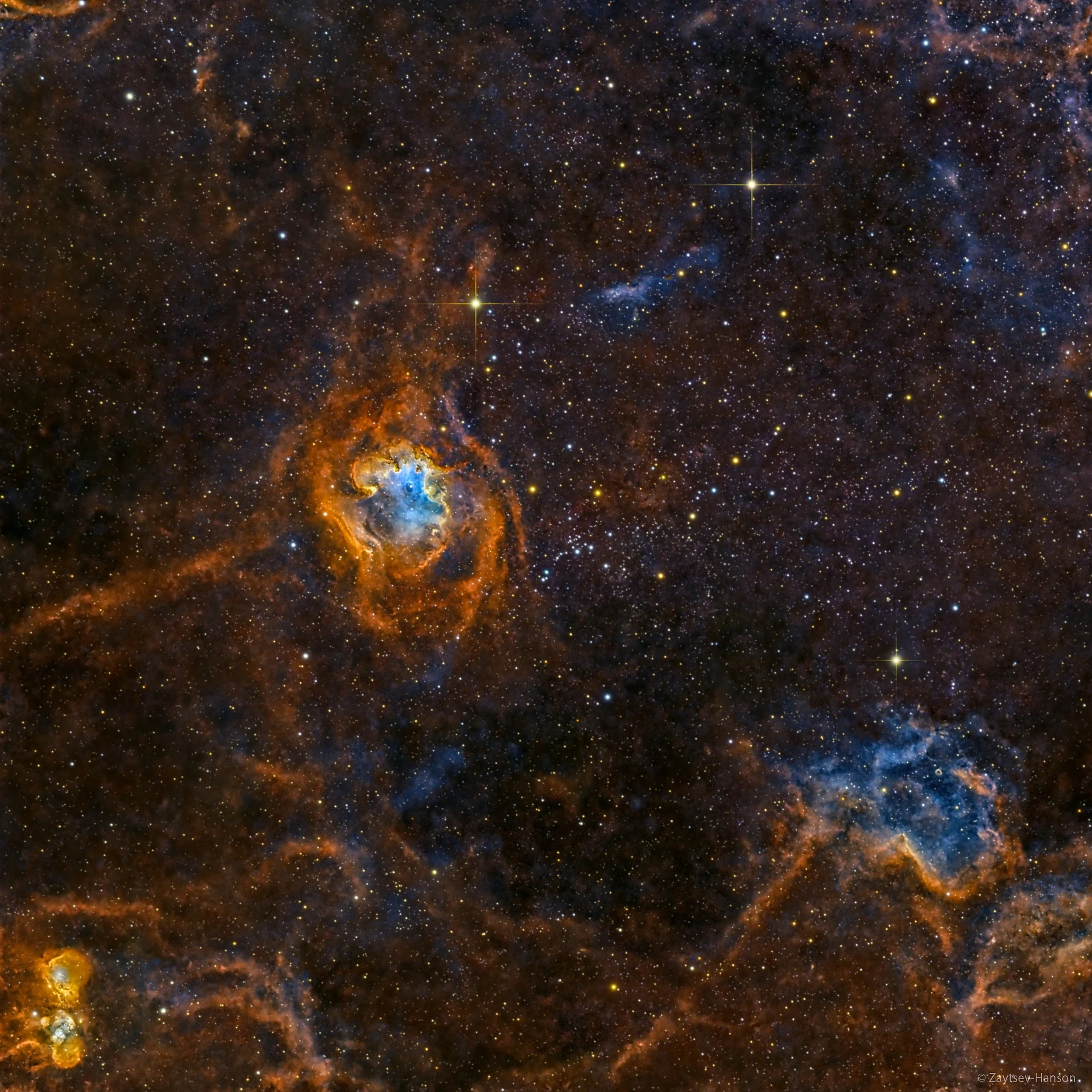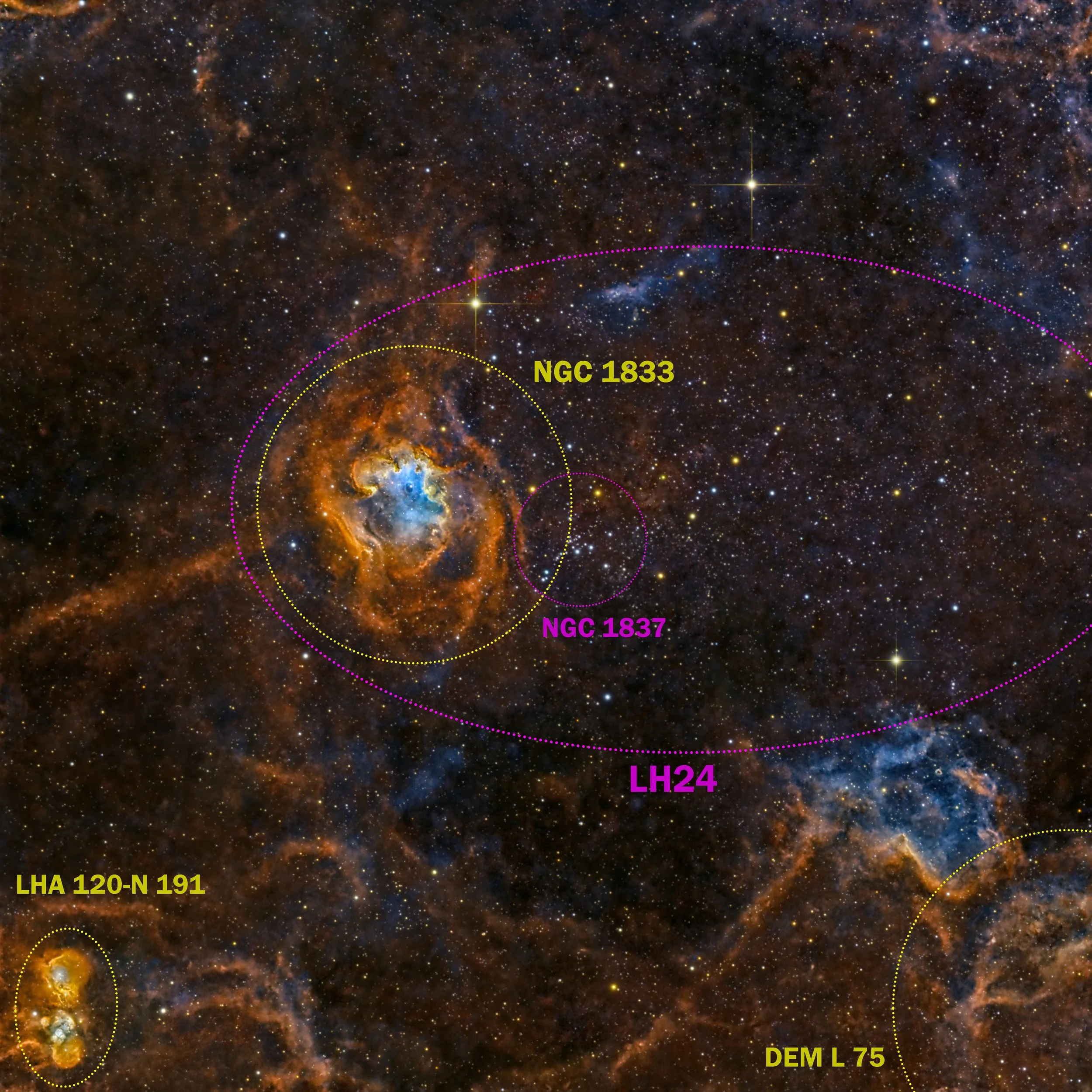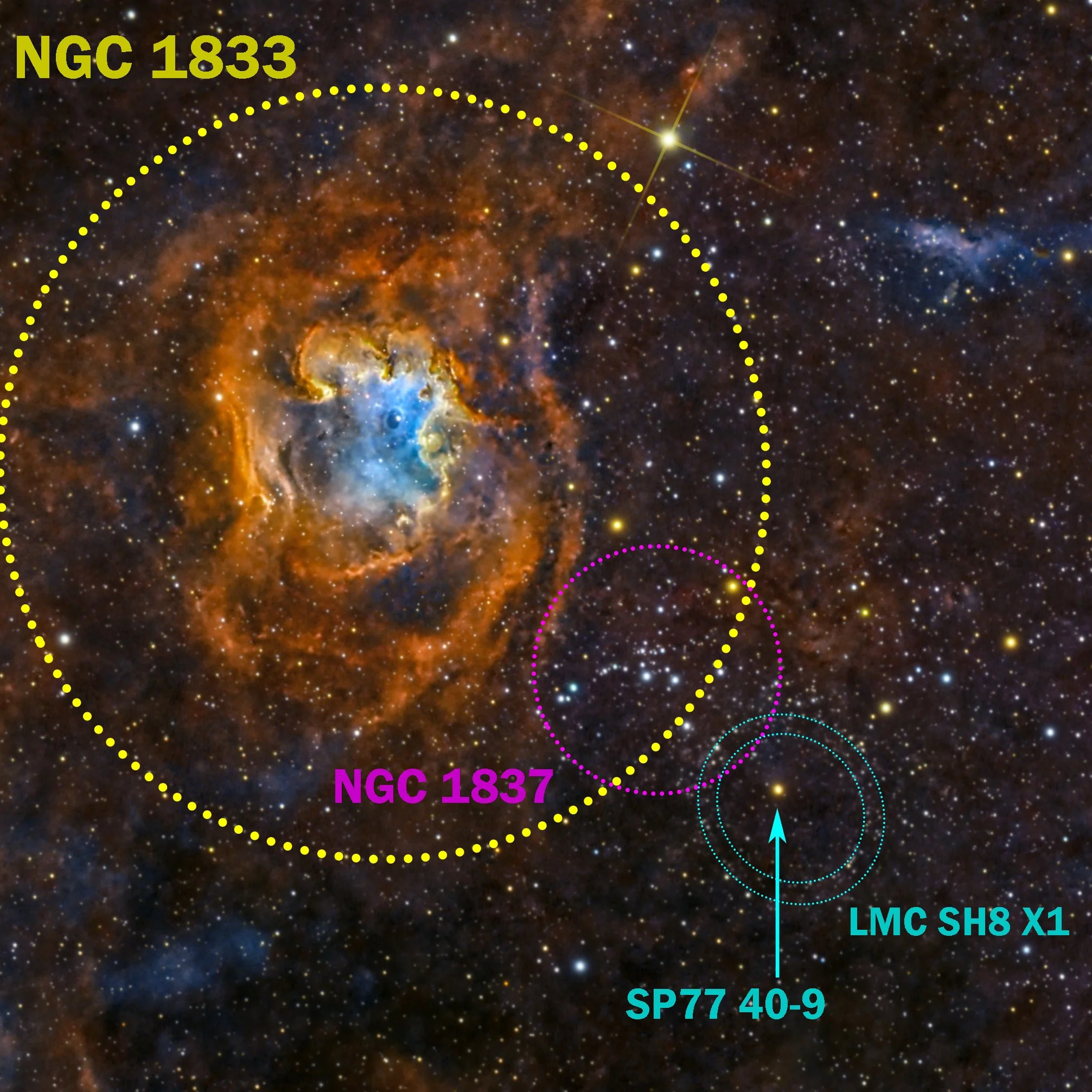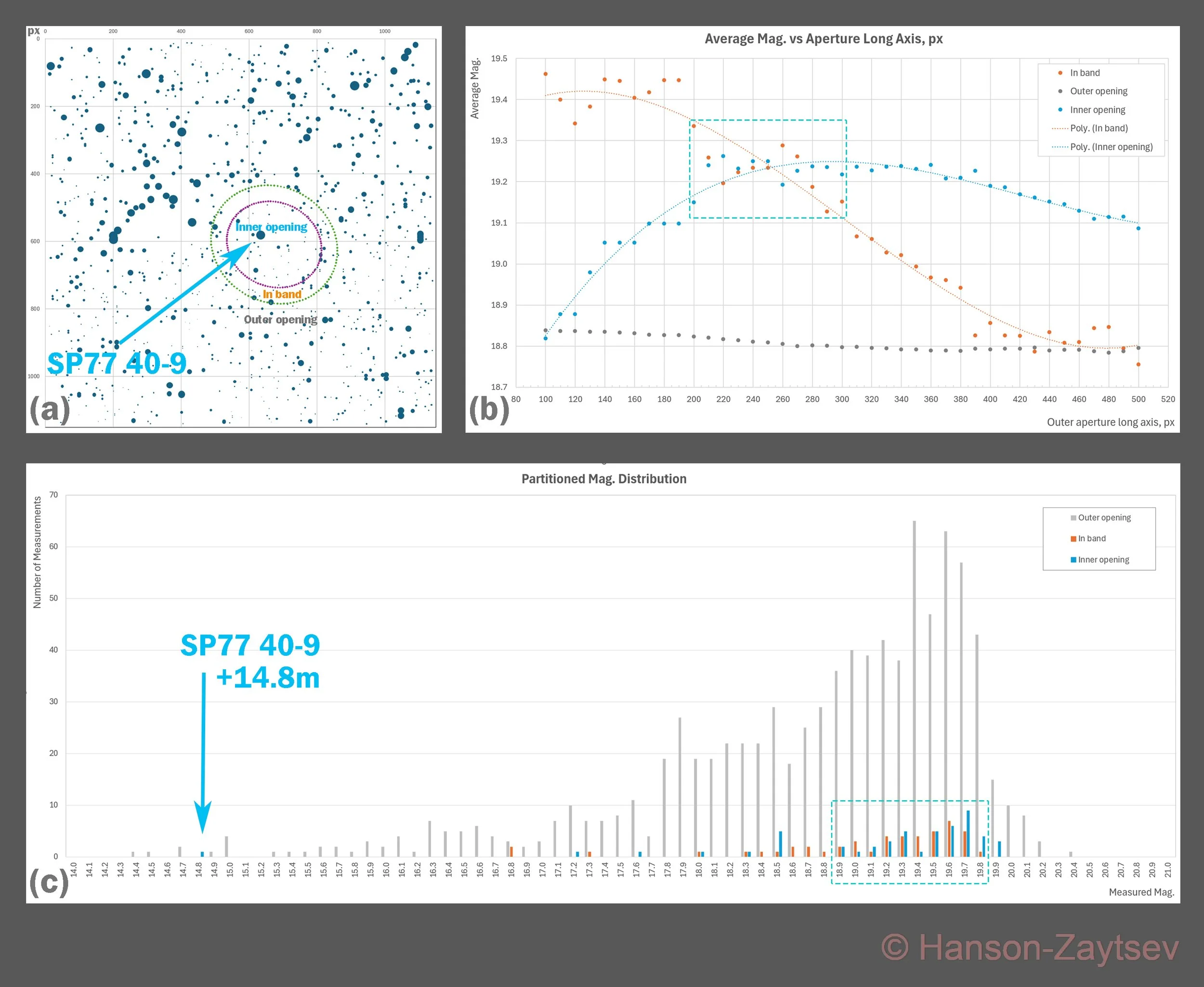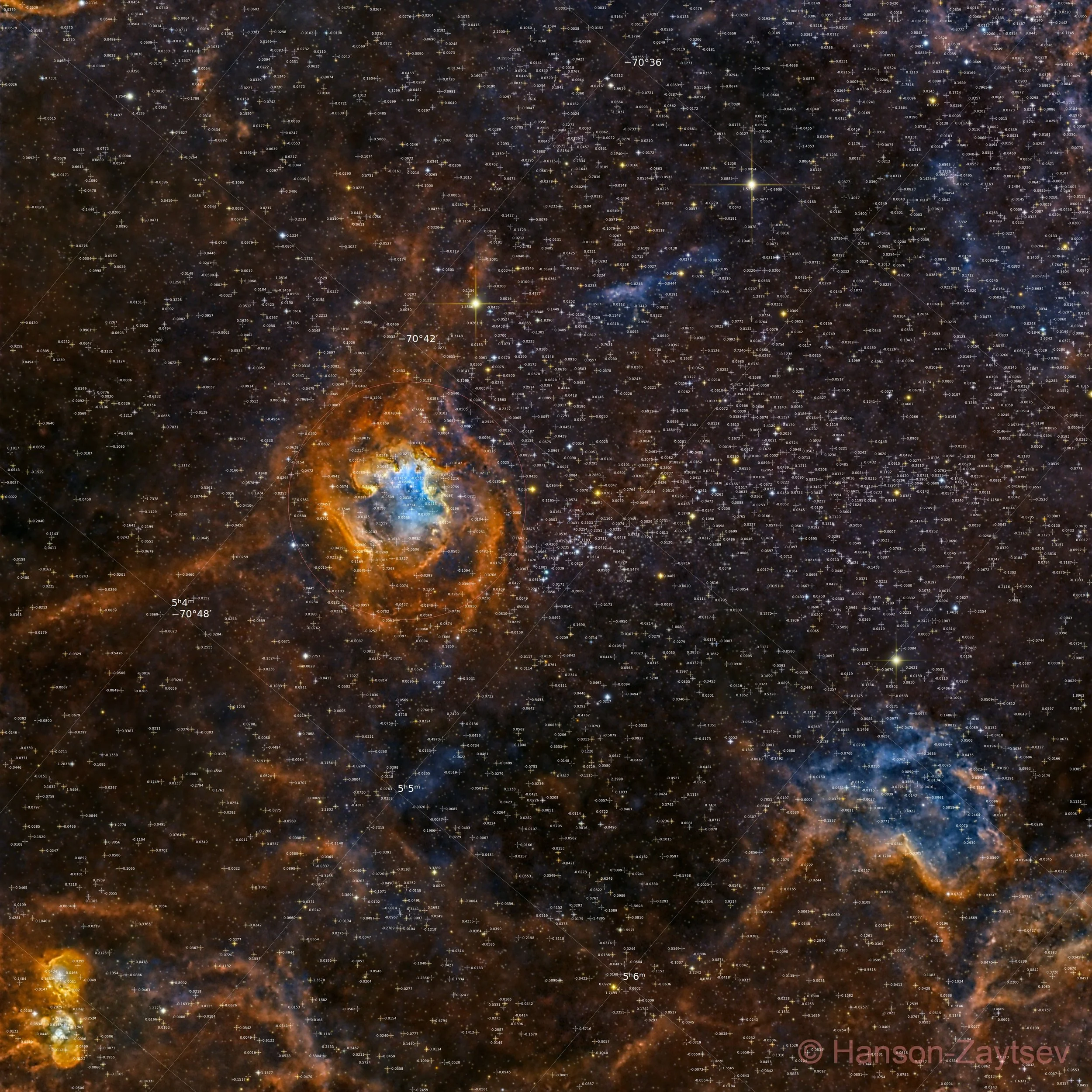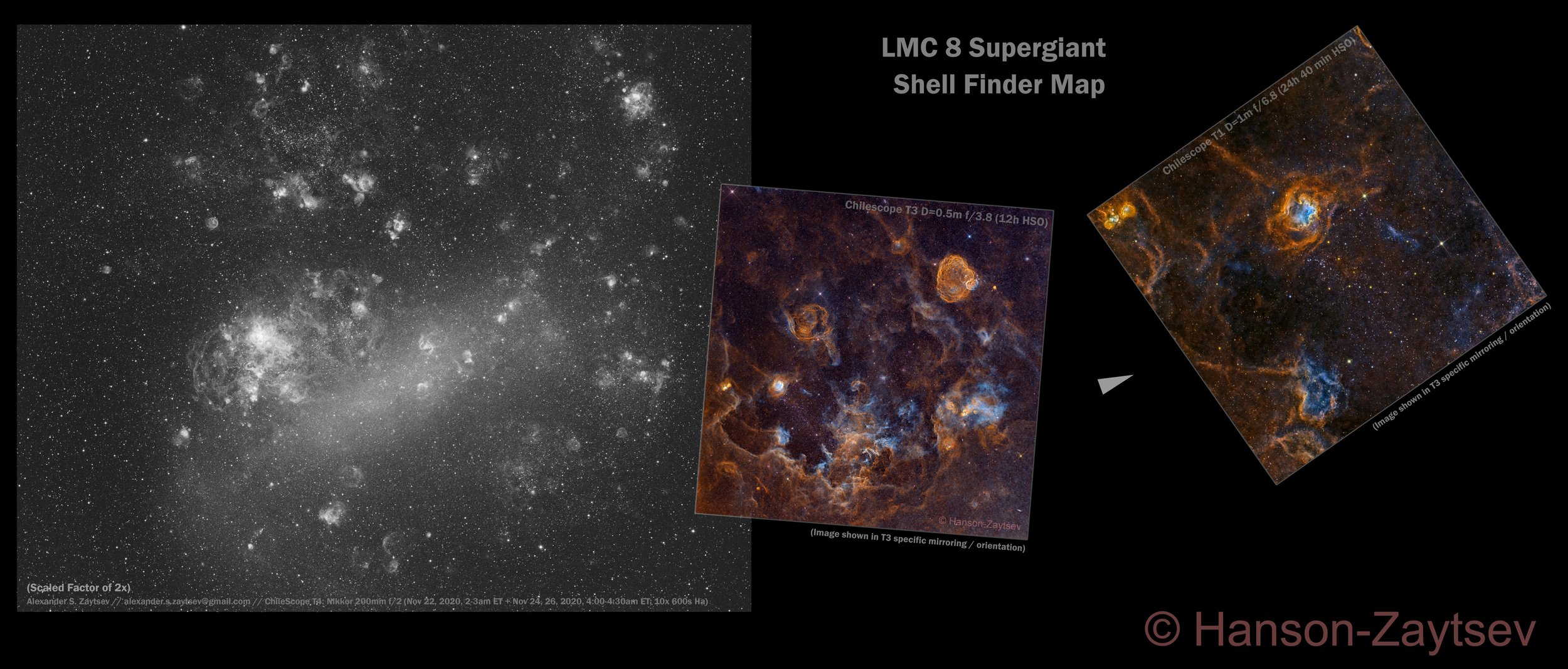NGC 1833 and its surroundings in the LMC
by Zaytsev and Hanson
Wonderful Description and Annotation By Alex Zaytsev
Here is a closer look at the part of the LMC 8 supergiant shell [1-4] located South-West of the Large Magellanic Cloud (LMC) containing the LH24 OB star association [5] with NGC 1833 emission nebula [6] and NGC 1837 open cluster [7] enclosed within obtained with the Chilescope T1 system (ASA Ritchey-Chretien RC-1000: D=1m, f/6.8). The Manually annotated version of the image is shown in Fig. 1. A wider angle view of this region near the LMC was also obtained earlier using the Chilescope T3 system (ASA-N D=0.5m, f/3.8) [8], yet significantly more details of internal structure are revealed here for the three main diffuse structures:
NGC 1833 [6] showing a compact (8.4 ly across by the longer axis at estimated distance to LMC of 158 kly) neutral gas feature in the inner volume of the nebula shown in Fig. 2.
DEM L 75 HII region [9] and nearby emission nebula complex also featuring another compact (5.8 ly across by the longer axis at estimated distance to LMC) neutral gas feature appearing to be fully surrounded by ionization fronts as shown in Fig. 3.
A peculiar bipolar LHA 120-N 191 object [10, 11] consisting of a compact HII region on one side and a more diffuse emission nebula on the other side shown in Fig. 4. The range of linear scales for substructures for this region is 6-50 ly - estimated based on distance to the LMC. According to [10, 11] the start population physically associated with the compact HII region LHA 120-N 191A are “only” 3-8 Myr of age which accounts for the relative compactness and high density of this region.
Fig. 1. Manually annotated version of the image shows in 100% of original scale.
Fig. 3. Manually annotated cropped version of the image showing emission nebula near DEM L 75 [9] at 200% of original resolution.
Fig. 5 shows the annotated cropped view of the central part of the image that contains (besides NGC 1833 [6] and NGC 1837 [7]) a peculiar elliptical asterism situated around the SP77 40-9 [12] long-period variable candidate star that is about 67 kly away based on Gaia DR3 [13, 14] parallax measurements. Yet, this central star appears rather bright at +14.8m and and also appears to be a part of a group of stars with similar parallax and brightness located in the vicinity of NGC 1837. The asterism was first identified in the Chilescope T3 image [8] and given a reference name of “LMC SH8 X1”. Remarkably so, the structure appears even more apparent in the Chilescope T1 image, and also more details of the background diffuse structures are visible in it as illustrated in Fig. 6 showing the region of interest at 200% of original resolution:
Figure. 6
Tiles (a) and (b) show the region in HOS colors with and without elliptical overlays indicating where the main concentration of point-like sources forming the asterism is. The dimensions of the overlays are 383px x 340px (in 100% of original resolution) = 104 arc.sec x 92 arc.sec (eccentricity 0.46) for the outer ellipse, and 290px x 243px (in 100% of original resolution) = 79 arc.sec x 66 arc.sec (eccentricity 0.55) for the inner ellipse.
Tile (c) shows the same HOS color version of the cropped image with an overlay of available parallax data values obtained from Gaia DR3 XPSD DB [15, 16]. Only a few stars in the band between inner and outer ellipses indicated turned out to have meaningful (positive) parallax values - these are shown with red underline - and these parallax values turned out to be in the range of 0.011 - 0.082 mas corresponding to 40 - 300 kly distance range. The parallax of the central star SP77 40-9 [12] is measured to be 0.0485 ± 0.0125 mas [12] corresponding to 67 ± 17 kly distance.
Tile (d) shows the same scene with all diffuse components removed to emphasize the point-like source components.
Tiles (e) and (f) are showing the same scene cast into black and white with the attempt to run the aperture photometry analysis procedure with PixInsight / Image Analysis / AperturePhotometry tool. Most of the faint sources in the asterism weren’t picked up by this procedure.
Fig. 2. Manually annotated cropped version of the image showing NGC 1833 [6] at 200% of original resolution.
Fig. 4. Manually annotated cropped version of the image showing a conglomeration of HIi regions and stellar shells LHA 120-N 191 [10, 11] at 200% of original resolution.
Fig. 5. Annotated cropped view of the central part of the image that contains (besides NGC 1833 [6] and NGC 1837 [7]) a peculiar elliptical asterism situated around SP77 40-9 [12] labeled as “LMC SH8 X1” - shown at 100% of original resolution.
Fig. 6. Several views to the sub-region of the original image containing the elliptical asterism “LMC SH8 X1” shown at 200% of original resolution with annotations.
Fig. 7
Applying the Aperture Photometry Tool [17] to the unstretched version of a subframe of the L channel master image led to better results as illustrated in Fig. 7:
Tile (a) shows the plot reconstructing the cropped version of the L channel integral image from photometric data extracted from it using the Aperture Photometry Tool [17]. The SP77 40-9 [12] +14.8m star is used for absolute calibration of star magnitude measurements. The image frame is split into 3 parts with two concentric and coaxial elliptical boundaries: the “inner opening”, the “outer opening”, and the “in band” area in between.
Tile (b) shows the result of calculating average magnitude for all objects in those 3 bands depending on the size of the long axis of inner opening, with 2 out of 3 graphs also provided with cubic polynomial approximation curves. The area where the curves corresponding to the “in band” and the “inner opening” parts are crossing is indicative of characteristic size of the asterism in question, containing many point-like sources of similar brightness and measured magnitudes sitting in the range of +18.9m - +19.8m. The ratio for both long and short axis of the inner and outer ellipses was locked to 1.32 and 1.4 correspondingly throughout the measurement procedure.
Tile (c) shows the histogram of measured magnitudes for all 3 bands for the configuration with long axis for the outer ellipse set to 290px = 79 arc.sec. The dashed box overlay shows the typical range of measured magnitudes for point-like sources forming the asterism.
Fig. 8 is showing all available data Gaia DR3 XPSD DB [15, 16] parallax data for the entire FOV of the original image (in units of mas and 100% of original resolution).
The apparent diameter of the elliptical shells of the asterism “LMC SH8 X1” of 66-104 arc.sec corresponds to 21 - 34 ly of linear size at the distance of 67 kly or 51 - 80 ly at the distance to the LMC of 158 kly. At this scale this structure (as long as it is a physically bound structure) could be
(H1) an unusually symmetrical star cluster formed on the boundary of an old and now dormant HII region embedded in a molecular cloud, part of which remained in unionized state. Many compact dark nebulae are detectable throughout the immediate vicinity of the asterism, but these could be overlaps from much closer molecular clouds located in Our galaxy. More exotic explanation could be that most of the objects in the elliptical band of this asterism are non-stellar, so they are either
Fig. 7. Photometric analysis of the asterism “LMC SH8 X1” and its surroundings using a subframe of the integral L channel exposure of the original image and the Aperture Photometry Tool [17].
Fig. 8. Original image with an overlay showing available parallax data based on Gaia DR3 XPSD DB [15, 16] for the entire field of view at 100% of original resolution. Parallax values are given in the units of mas. Note that many parallax values are negative, which indicates statistically insignificant measurements or measurements affected by some systematics yet to be corrected in the future Gaia data releases.
(H2) distant galaxies for which the structure is unresolved at this level of integral exposure / resolution, or
(H3) a result of gravitational lensing of a distant source located much further away behind the LMC on a massive object (or a group of objects) just happen to sit in the direction to the LMC and not visible in visual spectrum or IR (as neither Spitzer [18] nor Herschel [19] are showing up any bright sources associated with this structure). The full structure of arcs of the lensing image may not resolve in this but the peaks of intensity in the arcs could be showing up as point-like sources following a circular or elliptical path.
While hypothesis (H3) could explain the geometry of the asterism more easily, (H1) is probably still remaining a much more likely scenario. Further imaging with larger aperture systems and getting spectroscopic data for the faint sources forming the asterism are needed to clarify its nature and the formation mechanism.
The overall summary of position and size for the asterism “LMC SH8 X1” is as follows:
Calculated coordinates of the center (for both ellipses):
RA: 5 05 15.957 Dec: -70 42 10.94 (ICRS/J2000.0)Apparent size: 79 arc.sec x 66 arc.sec (inner ellipse)
104 arc.sec x 92 arc.sec (outer ellipse)Position angle of the long axis (for both ellipses): 74 deg
The angular diameter of the elliptical shells of 70-100 arc.sec correspond to 23 - 32 ly of linear size at the distance of 67 kly or 54 - 77 ly - at the distance to the LMC of 158 kly.
Data and initial calibration/integration: Alexandr Zaytsev https://www.astrobin.com/users/m57ring/
ASA Ritchey-Chretien RC-1000: D=1m, f/6.8 on alt-azimuthal direct drive fork mount, FLI ProLine 16803 with secondary mirror based motorized focusing and automatic de-rotation (Telescope #1 system of ChileScope observatory, Río Hurtado Valley, Chile).
23x Ha + 9x OIII + 10x SII guided 1800 sec exposures plus 22x L guided 600 sec exposures (24h 40min of combined integral) collected over 10 imaging sessions carried out on Oct 23, 24, 26, 2024 and Nov 2, 3, 4, 5, 18, 19,20, 21, 2024 using Chilescope Telescope #1 system.
Image Processing: Mark Hanson https://www.hansonastronomy.com
Enjoy, Mark and Alex
[1] https://iopscience.iop.org/article/10.1086/523897
[2] https://iopscience.iop.org/article/10.1086/523897/pdf
[3] https://astrodrudis.com/large-magellanic-cloud-nebulous-systems/
[7] https://theskylive.com/sky/deepsky/ngc1837-object
[8] https://www.astrobin.com/h5fb0p/
[10] https://www.aanda.org/articles/aa/abs/2012/09/aa19706-12/aa19706-12.html
[11] https://www.aanda.org/articles/aa/pdf/2012/09/aa19706-12.pdf
[13] https://www.aanda.org/articles/aa/abs/2023/06/aa43940-22/aa43940-22.html
[14] https://www.aanda.org/articles/aa/pdf/2023/06/aa43940-22.pdf
[15] https://www.cosmos.esa.int/web/gaia/data-release-3
[16] https://www.aanda.org/articles/aa/pdf/2023/06/aa43680-22.pdf
[17] https://www.aperturephotometry.org/
